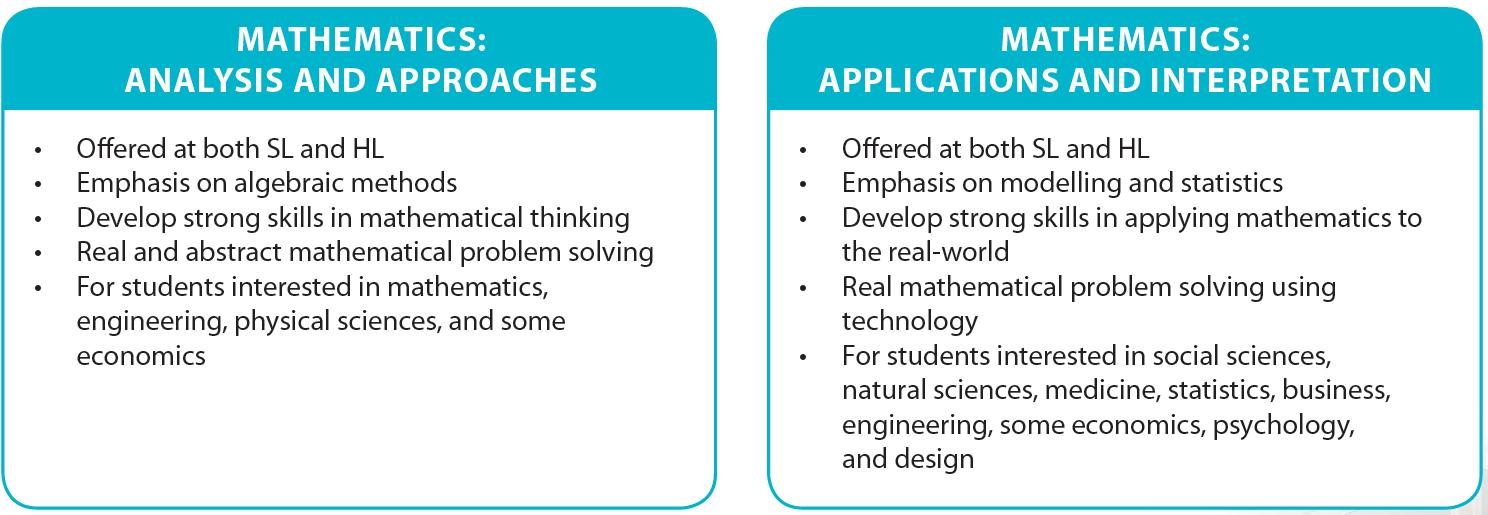
3 minute read
SL Maths - Applications & Interpretations
SL Maths - Applications & Interpretations
Comparison between the two courses:
This is a course which had its first examination in 2021 and is appropriate for students who intend studying a course at university with little or no mathematical content. For example, social sciences, humanities, English, psychology, the arts. It is not recommended for any courses which have some calculus content.
Aims:
The mathematics courses aim to contribute to students' personal attributes, subject understanding and global awareness by enabling them to: 1. develop a curiosity and enjoyment of mathematics and appreciate its elegance and power 2. develop an understanding of the concepts, principles and nature of mathematics 3. communicate mathematics clearly, concisely and confidently in a variety of contexts 4. develop logical and creative thinking, and patience and persistence in problem solving to instil confidence in using mathematics 5. employ and refine their powers of abstraction and generalization 6. take action to apply and transfer skills to alternative situations, to other areas of knowledge and to future developments in their local and global communities 7. appreciate how developments in technology and mathematics influence each other 8. appreciate the moral, social and ethical questions arising from the work of mathematicians and its applications 9. appreciate the universality of mathematics and its multicultural, international and historical perspectives 10. appreciate the contribution of mathematics to other disciplines, and as a particular “area of knowledge” in the TOK course 11. develop the ability to reflect critically upon their own work and the work of others 12. independently and collaboratively extend their understanding of mathematics
Course Description:
Students taking this course will normally follow courses at university which do not relate directly to Mathematics. Others may take this subject because they have an interest in
Mathematics, enjoy meeting its challenges and engaging with its problems and want to extend their understanding or skills. It is contained within the HL Applications course and covers approximately 60% of the content. The course covers five broad areas of Mathematics: number and algebra, geometry and trigonometry, functions, statistics and probability, and calculus. The students will need a graphical display calculator (GDC) which will be used throughout the course.
Students will complete an internal assessment worth 20% of their final grade. Students will learn to develop their mathematics for describing our world and solving practical problems. They will also learn to harness the power of technology alongside exploring mathematical models. They will enjoy mathematics in more practical contexts such as statistics.
Graphic Display Calculator (GDC)
Students are required to use a GDC throughout the course and during their exams. In Tanglin we use the TI n Spire CX, and all students are expected to buy this particular model. It is available for sale in the school shop.
Requirements:
Students will have completed (I)GCSE Mathematics or equivalent and have been accepted on to the IB Diploma course. They are sure they do not want to follow a course that relies on pure Mathematics at university. It is important that all students discuss which Mathematics course they should follow with an informed person prior to making a final decision. Students need to be particularly careful about choosing between Maths Applications SL and Maths Analysis SL. These two courses are viewed differently by different universities around the world.
Career Path:
Students will probably be looking at careers which do not involve Mathematics. If the student is unsure, it is advisable to check with the university the student would potentially like to attend to ensure that Maths Applications SL is acceptable for their prospective course.
Comparison between this course and A-Level
This is a Mathematics course designed for those students not formally needing Mathematics beyond the school level. A primary aim is to ensure that students retain, or if necessary develop, a solid understanding of those simple numerical and algebraic techniques which will be of use to them in future life, and the internal assessment allows students to develop an interest in an area of their choosing.
Assessment:
The course is assessed with two papers, one non-calculator and one calculator worth 80% and an "exploration" worth 20%. The exploration is a piece of written work undertaken in Term 3 of Year 12 which investigates an area of mathematics of their choosing.
Contact for further information:
Mr Chris Hollingworth: chris.hollingworth@tts.edu.sg Mrs Sarah Aldous: sarah.aldous@tts.edu.sg








